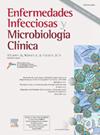Cost-effectiveness of cabotegravir versus tenofovir alafenamide plus emtricitabine versus tenofovir disoproxil fumarate plus emtricitabine for pre-exposure prophylaxis to prevent HIV-1 transmission in gay, bisexual and other men that have sex with men
IF 2.5
4区 医学
Q3 INFECTIOUS DISEASES
Enfermedades infecciosas y microbiologia clinica
Pub Date : 2025-08-01
DOI:10.1016/j.eimc.2024.12.023
引用次数: 0
Abstract
Introduction
This study aims to compare the cost-effectiveness of currently approved daily PrEP in Spain, with tenofovir disoproxil fumarate plus emtricitabine (TDF/FTC), in gay, bisexual and other men who have sex with men (GBMSM) versus newer alternatives like daily tenofovir alafenamide plus emtricitabine (TAF/FTC) or injectable cabotegravir every 2 months (CAB).
Methods
We fitted a dynamic compartmentalized Markov model that represents the dynamics of HIV-1 transmission in GBMSM in Spain. The model was calibrated to replicate the epidemiological data of the HIV epidemic in GBMSM in Spain from 2013 to 2018. We used the perspective of the national health system and applied a 40-year time horizon. Quality-adjusted life years (QALYs) were the health outcome variable, and the cost was accounted for in 2018 Euros (€). Our outcome variable was the incremental cost-effectiveness ratio (ICER) for PrEP. We used the 2018 gross domestic product per capita of Spain (€25,854) as the willingness-to-pay (WTP) threshold.
Results
The 2019 scenario with no PrEP in place would yield 17,424,891 QALYs and a cost of 2018 €17,345,310,254. The present scenario of daily TDF/FTC yields 18,615,325 QALYs, an increase of 1,190,434 QALYs at a cost of 2018 €15,354,878,534 (decrease of −2018 €1,990,431,719), generating an ICER of −2018 €1672 per QALY gained. The introduction of daily TAF/FTC in the present scenario would yield an increase in 449,392 QALYs at an additional cost of 2018 €13,634,260,217. The ICER would thus be 2018 €30,339 per QALY gained. Introducing CAB in the present scenario would yield an increase of 573,007 QALYs at an additional cost of 2018 €16,754,471,790 (average cost-effectiveness ratio = 29,239). Compared to TAF, the increase in QALYs would be 123,614 at an additional cost of 2018 €5,707,367,590, yielding an ICER of 2018 €46,170/QALY gained. A one-way sensitivity analysis and a probabilistic sensitivity analysis was carried out.
Conclusion
The present Spanish policy of PrEP is a cost-saving strategy. TAF/FTC and CAB are not cost-effective at current market prices.
卡博替韦与替诺福韦阿拉那胺加恩曲他滨对富马酸替诺福韦二氧吡酯加恩曲他滨暴露前预防在男同性恋、双性恋和其他男男性行为者中预防HIV-1传播的成本效益
本研究旨在比较西班牙目前批准的每日PrEP(富马酸替诺福韦二氧吡酯加恩曲他滨(TDF/FTC))在男同性恋、双性恋和其他男男性行为者(GBMSM)中的成本效益,以及较新的替代方案,如每日替诺福韦阿拉胺加恩曲他滨(TAF/FTC)或每2个月注射一次卡波特韦(CAB)。方法我们拟合了一个动态分区马尔可夫模型,该模型代表了西班牙GBMSM中HIV-1传播的动态。该模型经过校准,以复制2013年至2018年西班牙GBMSM中艾滋病毒流行的流行病学数据。我们采用了国家卫生系统的视角,并采用了40年的时间范围。质量调整生命年(QALYs)是健康结果变量,成本以2018欧元(€)计算。我们的结果变量是PrEP的增量成本效益比(ICER)。我们使用西班牙2018年人均国内生产总值(25,854欧元)作为支付意愿(WTP)阈值。结果2019年没有PrEP的情况将产生17,424,891个qaly, 2018年的成本为17,345,310,254欧元。目前每日TDF/FTC收益为18,615,325个QALY,增加1,190,434个QALY,成本为2018年15,354,878,534欧元(减少- 2018年1,990,431,719欧元),每QALY收益的ICER为- 2018年1672欧元。在当前情况下,每日TAF/FTC的引入将带来449,392个QALYs的增加,2018年的额外成本为13,634,260,217欧元。因此,2018年每获得QALY的ICER为30,339欧元。在目前的情况下,引入CAB将增加573,007个质量年,2018年的额外成本为16,754,471,790欧元(平均成本效益比= 29,239)。与TAF相比,QALY的增加将为123,614,2018年的额外成本为5,707,367,590欧元,2018年的ICER为46,170欧元/QALY。进行了单向敏感性分析和概率敏感性分析。结论西班牙现行的PrEP政策是一种节约成本的策略。TAF/FTC和CAB在目前的市场价格下并不具有成本效益。
本文章由计算机程序翻译,如有差异,请以英文原文为准。
求助全文
约1分钟内获得全文
求助全文
来源期刊
CiteScore
2.10
自引率
8.00%
发文量
194
审稿时长
29 days
期刊介绍:
Hoy está universalmente reconocida la renovada y creciente importancia de la patología infecciosa: aparición de nuevos agentes patógenos, de cepas resistentes, de procesos con expresión clínica hasta ahora desconocida, de cuadros de una gran complejidad. Paralelamente, la Microbiología y la Infectología Clínicas han experimentado un gran desarrollo como respuesta al reto planteado por la actual patología infecciosa. Enfermedades Infecciosas y Microbiología Clínica es la Publicación Oficial de la Sociedad Española SEIMC. Cumple con la garantía científica de esta Sociedad, la doble función de difundir trabajos de investigación, tanto clínicos como microbiológicos, referidos a la patología infecciosa, y contribuye a la formación continuada de los interesados en aquella patología mediante artículos orientados a ese fin y elaborados por autores de la mayor calificación invitados por la revista.

 求助内容:
求助内容: 应助结果提醒方式:
应助结果提醒方式:


